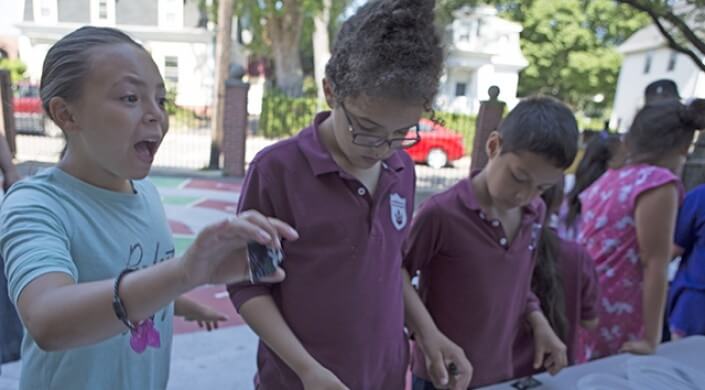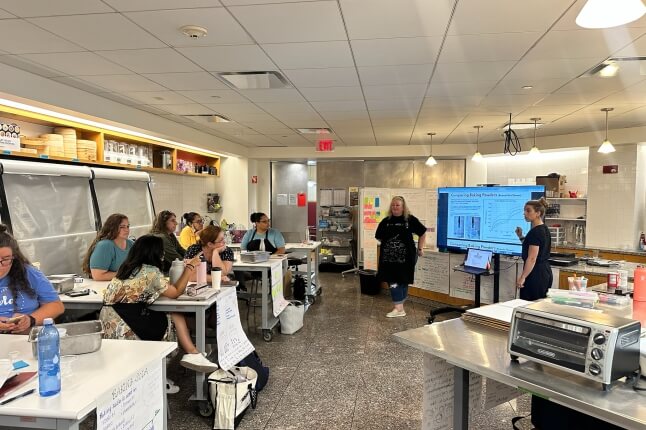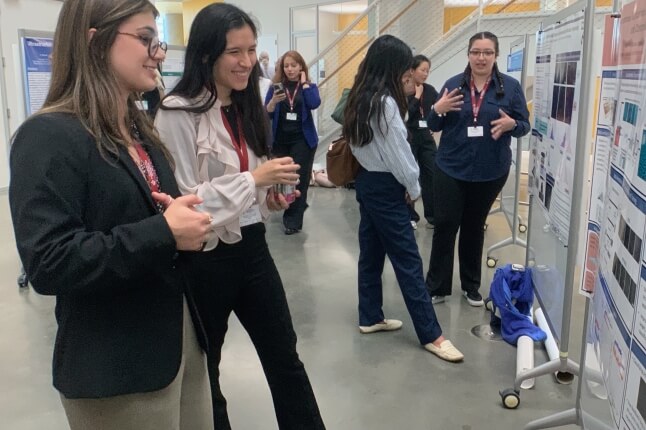News
Nine-year-old Star Velasquez, a second grader at the Gardner Pilot Academy, can’t contain her excitement when the super-thin film coating on a piece of paper reflects a rainbow of color. (Photo by Adam Zewe/SEAS Communications)
Nine-year-old Star Velasquez pulled a slip of paper from a container of water, her eyes lighting up with excitement as the black paper caught a glint of mid-morning sunlight and reflected a rainbow of color.
The experiment showcased the properties of super-thin films—nail polish dropped onto the top of the water spread into a nanometer-thick film that creates iridescent, rainbow colors on the paper.
Velasquez, a second grader at the Gardner Pilot Academy in Boston’s Allston neighborhood, and her peers learned about materials science during an outreach program conducted by students in the Research Experience for Undergraduates (REU) program at the Harvard John A. Paulson School of Engineering and Applied Sciences (SEAS).
In another hands-on experiment, elementary school children mixed blue and pink sand in water to learn about hydrophobic materials. The blue sand collected at the bottom of the water-filled beaker, while the pink sand, which was hydrophobic, reacted by clumping together when it hit the water to form a protective barrier.
Second grader Raul Galdamez, 8, said he had never seen anything like the clumping pink sand.
“I enjoy science because you can do experiments and learn new things about the world,” said Galdamez, who hopes to become an astronomer.
REU students Dominique Pablito (left) and Trisheena Kills Pretty Enemy use different colored sand to explain how hydrophobic materials interact with water. (Photo by Adam Zewe/SEAS Communications)
REU students Trisheena Kills Pretty Enemy and Dominique Pablito explained the scientific reaction as Galdamez and his peers watched the colored sand.
“This is my way of giving back, and it helps inflame my own passion for science,” said Kills Pretty Enemy, a senior majoring in microbiology at Montana State University. “This is all about planting the seed, especially for minorities, because there are not as many of us in the STEM field.”
She and Pablito are spending the summer conducting research on the microbiome in the lab of George Whitesides, Woodford L. and Ann A. Flowers University Professor. They are developing a fast and simple test for bacterial infections using a paper strip, similar to pH paper.
For Pablito, a senior majoring in chemistry and biology at the University of Utah, working with the elementary school children reminded her why she decided to pursue science.
“I like that you don’t always know the end results of your experiments, and you get to be creative in finding a solution,” she said. “With research, it always feels like a huge success when you figure something out, no matter how small it is.”
REU student Holly Cunningham, a sophomore at Princeton University majoring in operations research, oversees a hands-on science experiment demonstrating the properties of hydrogels. (Photo by Adam Zewe/SEAS Communications)
The joy of a successful experiment was apparent at a hydrogel demonstration overseen by Holly Cunningham and Jaylen Scott. Kids sprinkled white powder into cups half-filled with water; the powder absorbed the water and rapidly expanded into a puffy, white pile that spilled out the top of the cups, eliciting surprised laughs.
One of these kids might see an REU student who looks like them and think, ‘he’s a scientist, maybe I can be one, too.’
This powder, a polymer called polyacrylate, can absorb up to 1,000 times its weight in water, Cunningham explained to the kids.
“Being able to see science in action like this can help these kids really absorb the material,” said Cunningham, a sophomore at Princeton University majoring in operations research. “I love kids and I love encouraging them to enjoy science. Hopefully, some of them will develop a passion for it like I did when I was their age.”
Cunningham, working in the Privacy Tools Lab of Salil Vadhan, Vicky Joseph Professor of Computer Science and Applied Mathematics, enjoyed taking a break from the technical work to interact with such an excited group.
The outreach event is intended to help REU students increase their science communication skills, a goal of the annual program, explained Kathryn Hollar, Director of Community Engagement and Diversity Outreach at SEAS. The 70 students in this year’s cohort hail from New England, New Mexico, and everywhere in between, bringing a wide range of backgrounds to Harvard.
That diversity is important for the elementary school children to see, she said.
“Even more than teaching them about the materials, this event is an important opportunity for these kids to make a connection with young scientists,” she said. “One of these kids might see an REU student who looks like them and think, ‘he’s a scientist, maybe I can be one, too.’”
Cutting-edge science delivered direct to your inbox.
Join the Harvard SEAS mailing list.
Press Contact
Adam Zewe | 617-496-5878 | azewe@seas.harvard.edu



